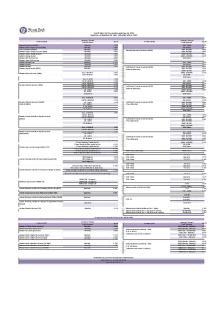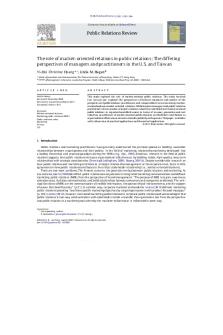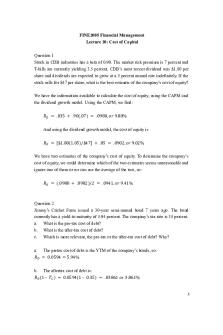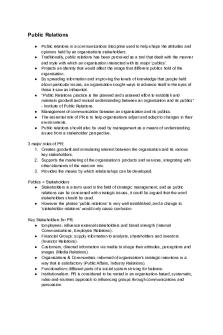Lecture 10 Solution - Pr. by Astrophel Choo PDF

| Title | Lecture 10 Solution - Pr. by Astrophel Choo |
|---|---|
| Course | Financial Management |
| Institution | 香港浸會大學 |
| Pages | 4 |
| File Size | 108.5 KB |
| File Type | |
| Total Downloads | 83 |
| Total Views | 147 |
Summary
Pr. by Astrophel Choo...
Description
FINE2005 Financial Management Lecture 10: Cost of Capital Question 1 Stock in CDB industries has a beta of 0.90. The market risk premium is 7 percent and T-bills are currently yielding 3.5 percent. CDB’s most recent dividend was $1.80 per share and dividends are expected to grow at a 5 percent annual rate indefinitely. If the stock sells for $47 per share, what is the best estimate of the company’s cost of equity? We have the information available to calculate the cost of equity, using the CAPM and the dividend growth model. Using the CAPM, we find: .035 .90.07 .0980, 9.80% And using the dividend growth model, the cost of equity is $1.801.05/$47 .05 .0902, 9.02% We have two estimates of the company’s cost of equity. To determine the company’s cost of equity, we could determine which of the two estimates seems unreasonable and ignore one of them or we can use the average of the two, so: .0980 .0902/2 .0941, 9.41%
Question 2 Jimmy’s Cricket Farm issued a 30-year semi-annual bond 7 years ago. The bond currently has a yield-to-maturity of 5.94 percent. The company’s tax rate is 35 percent. a. What is the pre-tax cost of debt? b.
What is the after-tax cost of debt?
c.
Which is more relevant, the pre-tax or the after-tax cost of debt? Why?
a.
The pretax cost of debt is the YTM of the company’s bonds, so:
0.0594 5.94% b.
The aftertax cost of debt is:
1– 0.05941– 0.35 .038613.861%
1
c. The after-tax rate is more relevant because that is the actual cost to the company as we need to take into consideration the tax advantage of debt issue.
Question 3 Remix Corporation has a target capital structure of 75 percent common stock, 5 percent preferred stock, and 20 percent debt. Its cost of equity is 11.25 percent, the cost of preferred stock is 5.5 percent, and the cost of debt is 6.1 percent. The relevant tax rate is 35 percent. a. What is Remix’s WACC? b. The company president has approached you about Remix’s capital structure. He wants to know why the company doesn’t use more preferred stock financing because it costs less than debt. What would you tell the president? a.
Using the equation to calculate the WACC, we find:
.75.1125 .05.055 .20.06101– .35 .0951, 9.51% b. Since interest is tax deductible and dividends are not, we must look at the aftertax cost of debt, which is: .0611–.35 .0397, 3.97% Hence, on an aftertax basis, debt is cheaper than the preferred stock.
2
Question 4 Given the following information for Janicek Power Co., find the WACC. Assume the company tax rate is 35 percent. Debt: 8500 semi-annual coupon bonds with a current market price of Common Stock:
$1180 and a yield-to-maturity of 5.82 percent. 225000 shares outstanding, selling for $87 per share; the beta is
Preferred Stock:
1.15. 15000 shares of preferred stock outstanding, paying a fixed dividend of $4.8 per year, currently selling for $98 per share.
Market:
7 percent market risk premium and 3.1 percent risk free rate.
8,500$1180 $10,030,000 225,000$87 $19,575,000 15,000$98 $1,470,000 And the total market value of the firm is: $10,030,000 19,575,000 1,470,000 $31,075,000 Now, we can find the cost of equity using the CAPM. The cost of equity is: .031 1.15.07 .1115, 11.15% The cost of debt is the YTM of the bonds, so: 5.82% And the aftertax cost of debt is: 1–.35.0582 .0379, 3.79% The cost of preferred stock is: 4.80/98 .0490, 4.90%
3
Now we have all of the components to calculate the WACC. The WACC is: .037910,030,000/31,075,000 .111519,575,000/31,075,000 .04901,470,000/31,075,000 .0848, 8.48% Question 5 Nally, Inc., is considering a project that will result in initial after tax cash savings of $4.2 million at the end of the first year, and these savings will grow at a rate of 2.5 percent per year indefinitely. The firm has a target capital structure of 80 percent common stock and 20 percent debt. The firm has a cost of equity of 13.1 percent, an after-tax cost of debt of 6.4 percent. The cost-saving proposal is somewhat riskier than the usual project that the firm undertakes; management uses the subject approach and applies an adjustment factor of +2 percent to the cost of capital for such risky projects. Under what circumstances should the company take on the project?
Using the debt-equity ratio to calculate the WACC, we find: 0.80.131 0.20.064 0.117611.76% Since the project is riskier than the company, we need to adjust the project discount rate for the additional risk. Using the subjective risk factor given, we find: 11.76% 2.00% 13.76% We would accept the project if the NPV is positive. The NPV is the PV of the cash outflows plus the PV of the cash inflows. The cash inflows are a growing perpetuity. If you remember, the equation for the PV of a growing perpetuity is the same as the dividend growth equation, so: $4,200,000/0.1376– 0.025 $37,300,177.62 The project should only be undertaken if its cost is less than $37,300,177.62 since costs less than this amount will result in a positive NPV.
4 ...
Similar Free PDFs

PR 10
- 48 Pages

New PR - Lecture notes 3
- 1 Pages

Problem set 10 solution
- 9 Pages

Chapter 10 Solution - Sol
- 21 Pages

HW-10-solution
- 5 Pages

Problem Set 10 Solution
- 5 Pages

Homework Solution 10
- 4 Pages

Case Study 10 solution
- 2 Pages

391567493-Jimmy-Choo
- 7 Pages

Week 2 PR Paper - Lecture notes
- 8 Pages

Lecture notes, lecture 10
- 5 Pages
Popular Institutions
- Tinajero National High School - Annex
- Politeknik Caltex Riau
- Yokohama City University
- SGT University
- University of Al-Qadisiyah
- Divine Word College of Vigan
- Techniek College Rotterdam
- Universidade de Santiago
- Universiti Teknologi MARA Cawangan Johor Kampus Pasir Gudang
- Poltekkes Kemenkes Yogyakarta
- Baguio City National High School
- Colegio san marcos
- preparatoria uno
- Centro de Bachillerato Tecnológico Industrial y de Servicios No. 107
- Dalian Maritime University
- Quang Trung Secondary School
- Colegio Tecnológico en Informática
- Corporación Regional de Educación Superior
- Grupo CEDVA
- Dar Al Uloom University
- Centro de Estudios Preuniversitarios de la Universidad Nacional de Ingeniería
- 上智大学
- Aakash International School, Nuna Majara
- San Felipe Neri Catholic School
- Kang Chiao International School - New Taipei City
- Misamis Occidental National High School
- Institución Educativa Escuela Normal Juan Ladrilleros
- Kolehiyo ng Pantukan
- Batanes State College
- Instituto Continental
- Sekolah Menengah Kejuruan Kesehatan Kaltara (Tarakan)
- Colegio de La Inmaculada Concepcion - Cebu




